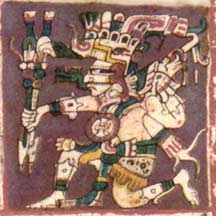 | MAYA HIEROGLYPHIC WRITING The Ancient Maya Codices | |
| THE DRESDEN CODEX We first learn of the Dresden Codex when we hear that Johann Christian Götze, Director of the Royal Library at Dresden, obtained the codex from the private owner in Vienna in 1739. In 1744, Götze gave it to the Royal Library, where it still resides. (The library's current name is the Sächsische Landesbibliothek). But not all has been "smooth sailing" for the Dresden; it sustained heavy water damage during the Dresden Fire Storms of WWII. Therefore, pre-WWII facsimiles are still very informative for study purposes. The following list includes some of the more interesting copies and facsimiles that have been produced: |  |
| 1. In 1810, Alexander von Humboldt published "Vues des Cordillères". This work includes pp. 47, 48, 50, 51, 52 of the Dresden in a beautiful, though somewhat not–completely–accurate, color rendition. I’ve seen copies of this book on sale for as much as $93,000, and for as little as $25,000, so it is a bit pricey, and quite a collector's item. 2. In 1825 or 1826, an Italian, Agostino Aglio, made a tracing of the Dresden Codex for Lord Kingsborough. It was uncolored, but was used in Lord Kingsborough's "Antiquities of México", published in 9 volumes (the last two posthumously; Kingsborough died of typhus in debtor's prison--the debt was accrued at least partly from these publications). Lord Kingsborough had Aglio’s rendition of the Dresden prepared in color for Volume III, in 1830 or 1831. Apparently it was colored by hand--for not all of the same-numbered pages from the different copies are identical (Justin Kerr's Photographs of the Kingsborough are available below). 3. In 1880, and again in 1892, Ernst Förstemann published the Dresden, in photochromolithographic editions, with perhaps only 60 copies produced in each edition (Gates, booklet with "The Dresden Codex", 1932). These have, of course, become extremely rare, and I have never seen an 1880 or 1892 copy for sale. Fortunately, the late Linda Schele attempted to have her copy, a gift from Floyd Lounsbury, become readily available. She not only provided a copy of Förstemann’s Dresden to FAMSI, but also to Cholsamaj Press, in Guatemala. Cholsamaj published facsimile versions that may still be available by contacting: cholsamaj@fundacioncholsamaj.org. (The Förstemann copy is available below.) J. Eric Thompson leaned heavily on photos of the Förstemann when making his rendition of the Dresden (published in "A Commentary on the Dresden Codex", Philadelphia, 1972). Lips and Deckert also made their rendition from the Förstemann editions (1962, Berlin). Andreas Fuls has made available a CD (for $20 as of April, 2002) of Förstemann's personal copy of the Förstemann, that is now housed in the Ibero-American Institute of Berlin. 4. In 1959, Ian Graham visited Dresden and made slides of the Dresden Codex (personal communication: Oct 17, 1998). From this collection of slides, I have seen only one print: a beautiful partial of Dresden page 49, in a book entitled "Vanished Civilizations of the World" (editor: Edward Bacon, Thames and Hudson, McGraw-Hill, 1963). 5. In 1932, William E. Gates published a facsimile rendition of the Dresden. It is very pleasing to the eye, colorful, and uses his own type-font for all the glyphs. I can't say that it is the most accurate rendition, but it is fun to look at. He said he produced 75 copies (Gates, booklet with "The Dresden Codex", 1932), but I have noticed some unnumbered copies of this edition that may have been put together from extra printed sheets that were picked up by graduate students some time later (personal communication of March or April 1997 with Jeremiah F. Epstein, who was a professor in the Department of Anthropology at the University of Texas, Austin). 6. In 1975, the Akademische Druck- u. Verlagsanstalt, of Graz, Austria, printed a facsimile from color photos of the WWII-damaged original, with commentary by Helmet Deckert and Ferdinand Anders. It is remarkably good, and the worst of the damaged pages have been reproduced again from Förstemann in a separate accompanying booklet. It, along with its Chiapas copy (within the book of Thomas A. Lee, Jr., "Los Códices Mayas", 1985) have been used as important stand-bys by Mayanists since their publications. Because the Dresden had fallen apart in previous years, later Europeans assigned to it page numbers that, upon later studying of the codex, proved to be incorrect. The page numbers were kept pretty much the same however, with the understanding that the order of the pages within the codex was probably 1-24, 46-74, and 25-45. Download the Dresden Codex NOTE: We've found that it's faster and easier to view these documents if you download the individual files to your computer and open them locally. To download and save, right click on the file, choose "save as" from the menu, pick a location ( for example "My Documents" ) and click "Save". The PDF files require Adobe Acrobat Reader. To download the latest version, click the Get Acrobat Reader button below. For those with a fast connection, download the complete PDF file: The complete Förstemann version of the Dresden Codex in PDF format (95.7 MB). The complete Kingsborough version of the Dresden Codex in PDF format. (48.2 MB). For those with slower connections download the PDF file in sections: The Förstemann version of the Dresden Codex in PDF format: Pages 01 - 12 (15.05 MB) The Kingsborough version of the Dresden Codex in PDF format: Title page - page 14 (10.4 MB) | |

No comments:
Post a Comment